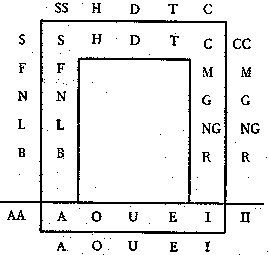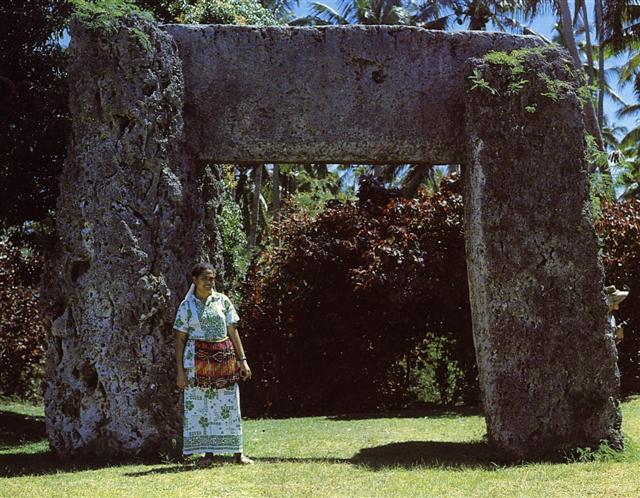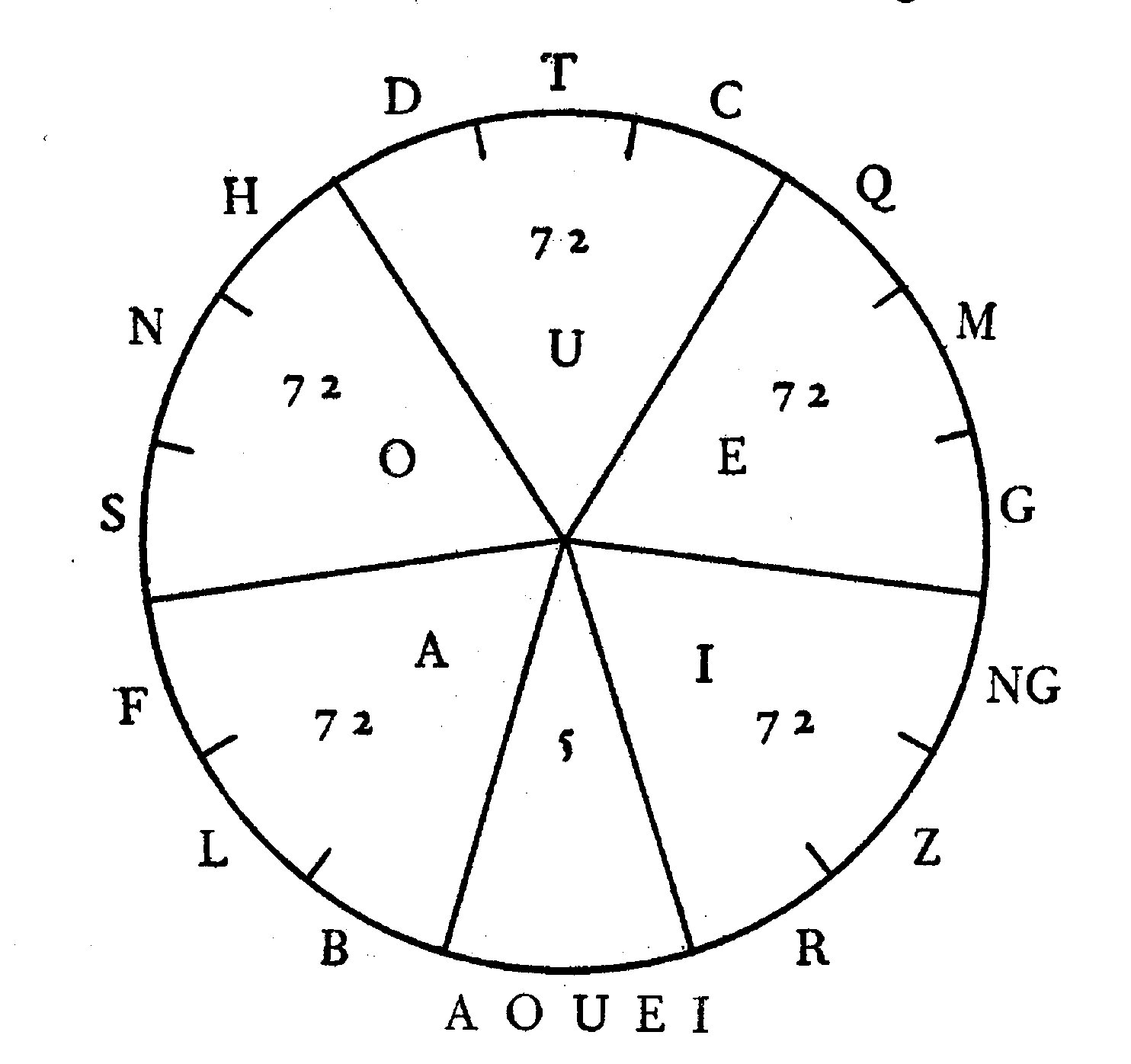223. The names Ephraim and Manasseh are explained on p. 270 (→ 264 + 6) of The White Goddess: "We can go further with the help of the names given to the tribes by their mothers in Genesis XXIX [29] and XXX [30], and of the prophetic blessings or curses bestowed on them by Jacob in Genesis XLVIII [48] and XLIX [49] we can assign a letter and month to each tribe. To Ephraim ('fruitful') and Manasseh ('forgetfulness'), the two sons of Joseph who was a 'fruitful vine' we can assign the months C and M ..." This pair of tribe names were presumably given in order to generate proper ideas → ... When this tremendous task had been accomplished Atea took a third husband, Fa'a-hotu, Make Fruitful. Then occurred a curious event. Whether Atea had wearied of bringing forth offspring we are not told, but certain it is that Atea and her husband Fa'a-hotu exchanged sexes. Then the [male] eyes of Atea glanced down at those of his wife Hotu and they begat Ru. It was this Ru who explored the whole earth and divided it into north, south, east, and west ... ... 'My child', said Makea now in a tone of deep sorrow, 'there has been a bad omen for us. When I performed the tohi ceremony over you I missed out a part of the prayers. I remembered it too late. I am afraid this means that you are going to die.' ... The father of Maui Tikitiki A Taranga, Makea Tutara, forgot an essentil part. An essentil part was also lost in the marshes of the Nile: ... The four bereaved and searching divinities, the two mothers and their two sons, were joined by a fifth, the moon-god Thoth (who appears sometimes in the form of an ibis-headed scribe, at other times in the form of a baboon), and together they found all of Osiris save his genital member, which had been swallowed by a fish ...
...Then the big Fish did swallow him, and
he had done acts worthy of blame.
But We cast him forth on the naked shore
in a state of sickness, These ideas could possibly be used in order to understand 'one of the halves' of Manasseh. 28 / 2 = 14 could refer to the upper half of him. ... The reference to Josua 13:7 is not so self-evident, it has to do with how the land already at an early time was divided between the 9 tribes and one of the halves of the tribe of Manasseh ... I have here below given an abstract of these tribal letters and their corresponding dates. The colours are assigned from my own colour convention, and likewise I have counted the day numbers. There are 28 days = 4 weeks between one date and the next. ... 'a day and a year' can be equated with the Thirteen Prison Locks that guarded Elphin, if each lock was a 28-day month and he was released on the extra day of the 365. The ancient common-law month in Britain, according to Blackstone's Commantaries (2, IX, 142) is 28 days long, unless otherwise stated, and a lunar month is still popularly so reckoned, although a true lunar month, or lunation, from new moon to new moon, is roughly 29½ days long, and though thirteen is supposed to be an unlucky number ... ... Ancient calendar-makers seem to have interposed the day which had no month, and was therefore not counted as part of the year, between the first and last of their artificial 28-day months: so that the farmer's year lasted, from the calendar-maker's point of view, literally a year and a day ... In other words, my suggestion that we at 2 Samuel 24:8 should count 9 months and 20 days as 9 * 30 + 20 = 290 needs to be complemented by the equation 9 * 28 + 20 = 272. Indeed, by way of the comments added to the pentagram we can perceive that Josua 13:7 might point at May 16 (136) because counting should begin with December 31 (364 + 1). From where 2 * 136 = 272 = 9 * 28 + 20, will explain 2 Samuel. And 24:8 could then refer to 24 * 8 = 192 = 384 / 2, corresponding to how 13:7 could refer to 13 * 7 = 91 = 182 / 2. From where we could imagine 384 - 182 = 202 to be an allusion to Ana-roto (Spica, *202).
... The plan of the five dolmen corresponds exactly with the disc alphabet, since there is a broad gap between the two standing nearest to the avenue (like the gap which contains the five holy days of the Egyptian, or Etruscan, year) and between the gap and the avenue stood a group of four smaller undressed stones [i.e. A, O, E, I], corresponding with the groups of three stones in the inner horseshoe, but with a gap in the middle; and far back, in the avenue itself, the huge undressed 'Heel' stone [U] made a fifth and central one. This is not to assume that Stonehenge was built to conform with the disc-alphabet. The calendar may have anteceded the alphabet by some centuries. All that seems clear is that the Greek alphabetic formula which gives the Boibel-Loth its letter-names is at least a century or two earlier than 400 B.C. when the Battle of the Trees were fought in Britain. The formula is plain. The Sun-god of Stonehenge was the Lord of Days, and the thirty arches of the outer circle and the thirty posts of the inner circle stood for the days of the ordinary Egyptian month; but the secret enclosed by the these circles was that the solar year was divided into five seasons, each in turn divided into three twenty-four-day periods, represented by the three smaller posts in front of the dolmens. For the circle was so sited that at dawn of the summer solstice the sun rose exactly at the end of the avenue in dead line with the altar and the Heel stone; while, of the surviving pair of four undressed stones, one marks the sun's rising at the winter solstice, the other its setting at the summer solstice ...
"For the extra day, Dec. 23rd, which belongs to Benjamin, 'Son of My Right Hand', that is to say 'The Ruler of the South', (since the Sun reaches its most southerly stage in mid-winter) the jewel is amber, which Ezekiel makes the colour of the upper half of Jehovah's body; the lower half being fire." ... The Road of the Spider, which is also referred to in Hawaiian literature as ala-kuukuu, suggests the path by which the Sun spirals north to the June solstice, rising higher and higher each day in the sky of the northern hemisphere, and thence south to the equinox and the December solstice attaining a lower altitude each day, i.e., a combination of its daily and yearly motions. The symbolism is not difficult to perceive if one visualizes the motion of the Sun as continuous from day to day ...
|
||||||||||||||||||||||||||||||||||||||||||||||||||||||||||||




